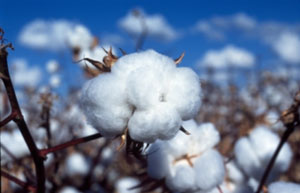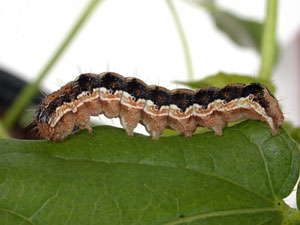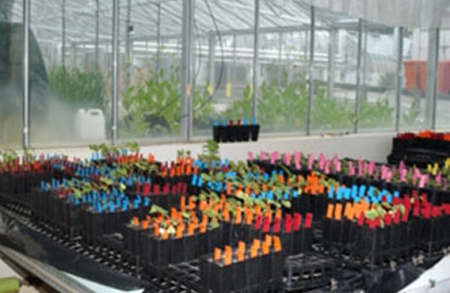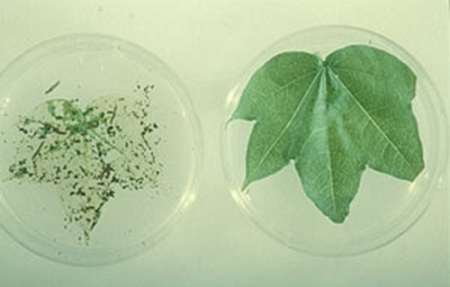Genetically modified cotton varieties
CSIRO has been the driving force behind the development, deployment and adoption of Genetically Modified (GM) cotton varieties in Australia. Dr Greg Constable, Dr Danny Llewellyn (CSIRO Plant Industry) and Dr Gary Fitt (CSIRO Entomology) have helped place CSIRO at the forefront of global cotton research and maintain Australia as a world leader in cotton production. Today, Australia’s cotton industry is almost entirely dependent on the growing of GM cotton varieties produced by these outstanding scientists and their teams.
Their work focused on the development of GM cotton varieties and their accompanying resistance management packages for both the domestic and international cotton markets. Their research has allowed the cotton industry to substantially reduce the use of environmentally damaging pesticides and herbicides. When they grow GM varieties, cotton farmers now use over 85% less insecticides, 62% less residual grass herbicides and 33% less residual broadleaf weed herbicides.
The industry has an export value of over $1.5 billion per annum, for the production of fine count cotton yarns. Cotton was the first GM field crop grown in Australia and the GM cotton varieties have been used by Australian growers since the late 1990s yielding significant environmental and economic benefits.
In recognition of their contributions to Australian agricultural sustainability Greg Constable and Danny Llewellyn were awarded the CSIRO Chairman’s Medal in 2003 and with Gary Fitt the ATSE Clunies Ross Award in 2006.

Chemical pesticides during the 1980s
The cotton industry, encompassing up to 500 000 hectares, had become a major export earner for Australia, but at some cost. Its sustainability began to be questioned in the 1980s because of its heavy dependence on chemical inputs for insect and weed control and the increasing prevalence of pesticide resistant pests and weeds. GM technologies that were emerging in the late 1980s offered a potential alternative by altering the genetic make-up of crops like cotton to produce their own insecticidal proteins or to make them insensitive to more environmentally friendly herbicides.
In collaboration with the Monsanto Company, that had developed the first insecticidal gene (Ingard®) active against the major caterpillar pests of cotton in Australia, Drs Constable, Llewellyn and Fitt pioneered the introduction of this insecticidal gene into Australian cotton in the early 1990s and have gone on to incorporate other genes over time. CSIRO had, and still has, a dominant position as the major supplier of cotton varieties for the Australian industry, and increasingly to other parts of the world, and provided the ideal vehicle to deliver the new GM traits to market.

GM cotton to the rescue, fostering a more sustainable industry into the 1990s and 2000s
Dr Constable’s skills in plant breeding, field evaluation and agronomy were combined with Dr Llewellyn’s skills in plant molecular biology, antibody diagnostic screening and close ties with Australian regulatory agencies and Dr Fitt’s skills in entomology and ecology to rapidly establish a world class GM cotton breeding program to incorporate Monsanto’s GM traits into Australian varieties. In record time, over four years, they and their seed company partners developed the first commercial cultivars of GM insect tolerant cotton along with clear guidelines for the growing and management of these varieties. This is crucial to minimise the impacts of the target pest insects developing resistance to the plants as had often happened when any new chemical insecticide had been released and used on a large scale in the industry.
Dr Constable was responsible for the extensive back-cross breeding, field selection, seed production and transfer of material to CSIRO’s seed partner. Dr Llewellyn was responsible for the development and application of diagnostic tools to follow the transgene through the large breeding populations. He screened breeding lines and put in place a quality control system prior to transfer of material to the major Australian cotton seed company, Cotton Seed Distributors (CSD), who multiplied seed for sale to growers. Dr Fitt put in place research which developed the elements of a resistance management strategy using a system of growing ‘refuge’ crops along with the GM cotton that is now widely used around the world with similar GM crops. All scientists managed experiments and worked closely with other scientists gathering additional information required by regulatory agencies on defining and minimising the risks associated with GM cotton field trials prior to their commercial launch.

Ingard® and Bollgard® II cotton varieties
Released as Ingard® cotton in 1996 the first GM insect tolerant CSIRO varieties were rapidly adopted by the Australian industry. Because of the potential for the target insects to develop resistance, the allowable area for planting of Ingard® cotton was restricted to up to 30% of the total area planted on any farm and growers fully subscribed to the maximum area allowed. After six years Ingard® was replaced by a better two gene product (Bollgard® II) that did not have the same area restrictions because of its in-built resistance management properties. Pesticide usage in Bollgard® II cotton was reduced by 80% each year resulting in significant reductions in the total chemical load on the environment in cotton cropping areas.

Following the development of Ingard® and Bollgard® II cotton, breeding into CSIRO varieties also began with the Monsanto Roundup Ready® gene which confers tolerance to the environmentally friendly herbicide glyphosate. After its release in 2000 it was also adopted rapidly by growers. The area grown rose rapidly to over 100 000 hectares in 2001 and continued to rise when combined with the Ingard® or Bollgard® II trait in the best available CSIRO germplasm. These herbicide tolerant GM varieties have enabled a reduction in the use of residual grass herbicides by 62% and residual broadleaf weed herbicides by 33% on a significant proportion of the area sown to cotton. It has also reduced the need for hand chipping of weeds and mechanical cultivation. Both have important human health and safety and land conservation implications for the industry and in combination a major impact on the profitability and sustainability of Australian cotton production, benefiting all Australians.

Improvements continue to increase the economic and environmental benefits of growing GM cotton
Improved GM varieties have continued to be developed in even better germplasm and new CSIRO varieties are combined with new GM traits as they become available and are approved by Regulatory Authorities. There is now an improved Roundup Ready® Flex trait developed by Monsanto and more recently a different herbicide trait called Liberty Link from Bayer CropScience. The various combinations of all of these GM traits are making the Australian cotton industry one of the ‘greenest’ and most efficient in the world. These CSIRO bred GM varieties are also now being sold internationally through Bayer CropScience, particularly in the Americas where they now have significant share of area in parts of the US and South America.
The GM cottons sold by CSD are now planted on well over 90% of the cotton area in Australia and are being continually improved by being replaced with new CSIRO germplasm with higher yields, higher fibre quality and more tolerance to the diseases and other pests that assail cotton in Australia. This will ensure that Australian cotton always has the best combination of GM traits and conventional genetic make-up to keep it competitive in a global fibre market.

A continuing tradition
The CSIRO Plant Industry breeding team has a long tradition of recognition for its achievements that predates the introduction of GM technologies.
Dr Norm Thomson was made a Member of the Order of Australia (AM) in 1989 and was awarded the Sir Ian McLennan Achievement for Industry Award in 1990 for pioneering the successful breeding program including the breeding of two new and successful cotton varieties, Siokra and Sicala. Norm was the original Officer in Charge of CSIRO’s move in 1972 to Narrabri and in setting up the modern cotton breeding program.
Peter Reid, a long term cotton breeder with CSIRO, was awarded the Sir Ian McLennan Achievement for Industry Award in 2005 for the development of elite cotton variety germplasm which had made a substantial impact on industry profitability. These new cotton varieties provided international benchmarks in yield, disease resistance and fibre quality.
Both Norm Thomson and Peter Reid have now retired from CSIRO but their legacy and tradition are evident in the new cotton varieties still being developed and that will continue into the future.
In continuing this tradition Drs Constable, Llewellyn and Fitt work closely with industry to ensure that new GM varieties meet grower expectations and needs, and are household names amongst Australia’s cotton growers. They have forged close links with industry including Monsanto and Bayer CropScience to provide access to a number of different GM traits in CSIRO varieties, as well as with the regulatory agencies such as the OGTR, APVMA and FSANZ. These agencies are responsible for ensuring that new GM products are safe and actively seek Drs Constable, Llewellyn and Fitt’s advice and participation in the development of Australia’s regulatory framework for GM crops and in providing research to underpin their regulatory assessments.
Cotton was the first GM crop to be grown in Australia and has delivered considerable economic, social and environmental benefits to Australian farmers over the last twelve years and those benefits will continue to accrue and increase into the future.
Source
- Catizone I, 2009, Personal communication.
